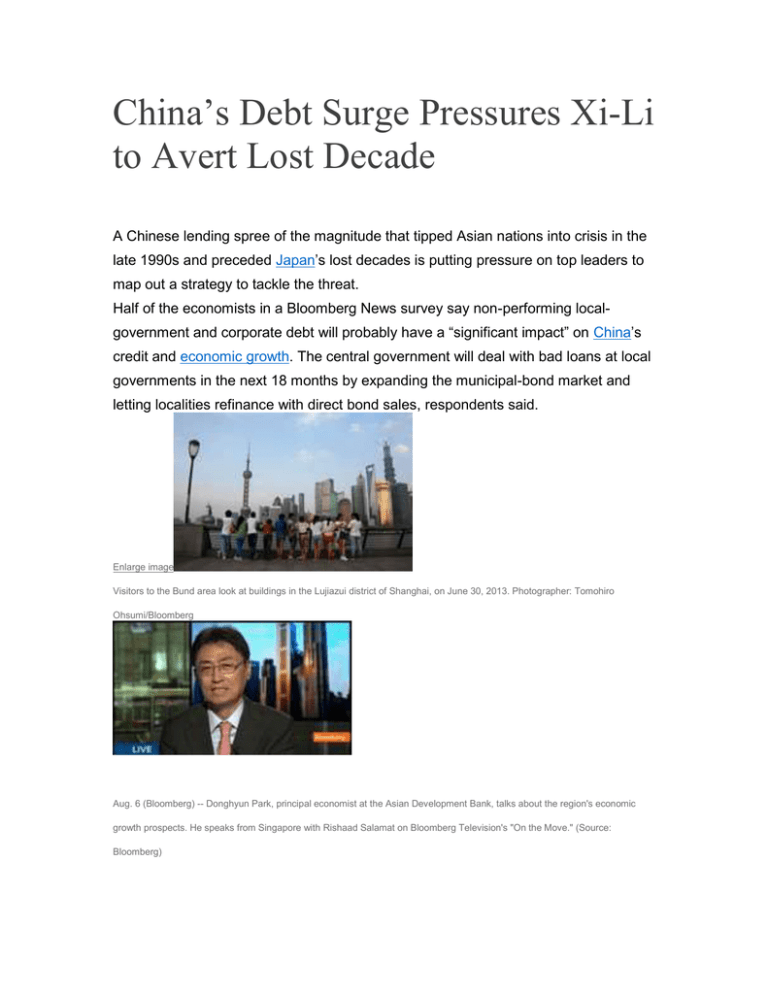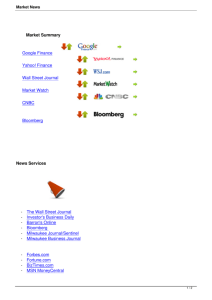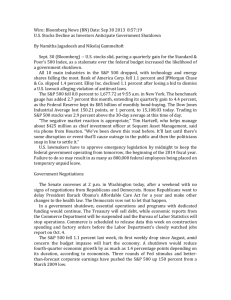IMF Report
advertisement

China’s Debt Surge Pressures Xi-Li to Avert Lost Decade A Chinese lending spree of the magnitude that tipped Asian nations into crisis in the late 1990s and preceded Japan’s lost decades is putting pressure on top leaders to map out a strategy to tackle the threat. Half of the economists in a Bloomberg News survey say non-performing localgovernment and corporate debt will probably have a “significant impact” on China’s credit and economic growth. The central government will deal with bad loans at local governments in the next 18 months by expanding the municipal-bond market and letting localities refinance with direct bond sales, respondents said. Enlarge image Visitors to the Bund area look at buildings in the Lujiazui district of Shanghai, on June 30, 2013. Photographer: Tomohiro Ohsumi/Bloomberg 3:34 Aug. 6 (Bloomberg) -- Donghyun Park, principal economist at the Asian Development Bank, talks about the region's economic growth prospects. He speaks from Singapore with Rishaad Salamat on Bloomberg Television's "On the Move." (Source: Bloomberg) 4:38 Aug. 5 (Bloomberg) -- David Gaud, a Hong Kong-based senior portfolio manager at the asset management unit of Edmond de Rothschild Group, talks about the impact of Federal Reserve and European Central Bank monetary policies on markets, and the outlook for China stocks. Gaud speaks with Zeb Eckert on Bloomberg Television's "First Up." (Source: Bloomberg) Avoiding a fate akin to Japan’s growth collapse of the 1990s hinges on Chinese officials’ ability to reduce debt and shift policy, JPMorgan Chase & Co. says. President Xi Jinping and Premier Li Keqiang, developing a reform strategy due at a Communist Party meeting later this year, may get input from a State Council-ordered audit of government borrowings and a World Bank-assisted study on urbanization. “The debt ratio is absolutely dangerous, there is no question,” said Yao Wei, China economist at Societe Generale SA in Hong Kong, ranked by Bloomberg as the most accurate forecaster of the nation’s gross domestic product. “There is a high risk that this debt issue will have significant downside pressure on Chinese growth in the next few years.” Local-government debt may have surged by as much as 50 percent since the end of 2010. Borrowings as of June 30 ranged from 15 trillion yuan ($2.4 trillion) to 16 trillion yuan, according to estimates of four analysts. Audit Estimate That compares with the National Audit Office’s 10.7 trillion yuan estimate for the end of 2010. The agency said July 28 that the cabinet ordered a new nationwide review of government debt. China today and Japan in the 1980s share a buildup in broad measures of credit to almost double the economy’s size, JPMorgan analysts said in a July 19 report. China’s credit-to-GDP ratio rose to 187 percent in 2012 from 105 percent in 2000, compared with Japan’s increase to 176 percent in 1990 from 127 percent in 1980, JPMorgan said. Investor inquiries on the similarities between China now and Japan then prompted the report, said Grace Ng, a JPMorgan economist in Hong Kong. “Normally and internationally speaking, if a country’s debt ratio increases so rapidly, its probability of financial crisis is higher,” Ng said. Mitigating Forces While risks may be reduced by forces such as that the increase is in debt held mainly by domestic investors and the national savings rate is more than 50 percent of GDP, “these mitigating factors also existed in Japan in the late 1980s,” JPMorgan said in its report. Goldman Sachs Group Inc. draws a comparison to the Asian crisis of 1997-98, saying China’s debt-to-GDP ratio has increased by 56 percentage points in the five years through 2012.Thailand had an advance of 66 percentage points and Malaysia’s was 40 percentage points in the five years before Asia’s turmoil, Goldman Sachs said in a July 26 report. Nomura Holdings Inc. said earlier this year that the “5-30” rule shows rising risks of a financial crisis in China. That’s because leverage in Japan, Europe and the U.S. increased by about 30 percent of GDP in the five years before crises, compared with Nomura’s estimate of 34 percent in the five years through 2012 for China. IMF Report China’s stock of credit is among the highest in the world at its level of per capita GDP, theInternational Monetary Fund said last month in its annual report on the nation’s economy. Yet comparisons with Japan are “misplaced” because Japan also had property and stock bubbles that burst with “debilitating consequences,” said Murtaza Syed, IMF deputy resident representative in Beijing. “China is still at a relatively early stage of its development, and so with the right policies and reforms it can look forward to many years of still relatively strong growth,” Syed said. Investors will see China’s progress in tackling the issue in July credit and lending data due by Aug. 15, with the median analyst estimate for money-supply growth of 13.9 percent. That’s down from 14 percent in June, when a governmentengineered cash squeeze helped curb shadow banking. The Asian Development Bank may lower its 2013 and 2014 growth forecasts for China in October, Chief Economist Rhee Chang Yong said in an e-mail yesterday. The bank in a July 16 report gave a 2013 projection for 7.7 percent expansion. Detroit Filing Last month’s bankruptcy filing by the U.S. city of Detroit “sounded alarms for many local Chinese governments,” said Hu Yifan, chief economist at Haitong International Securities Group in Hong Kong. The situation is “actually not so scary if you take the size of state-owned assets into consideration,” Hu said. Yu Yongding, a former central bank adviser, estimated the assets’ value at 100 trillion yuan, almost double GDP. Even so, policy makers “better not fall asleep” on crisis risks, Yu said at a July 31 forum in Beijing. “I’m suspicious of local governments’ willingness and abilities to repay their debts,” Yu said. The World Bank said in November it’s working with the State Council’s Development Research Center on an urbanization study, at Premier Li’s request, after copublishing a report last year proposing reforms so China can become a high-income society by 2030. Growth Impact Concern that financial risks will harm growth has weighed on stocks this year, with the Shanghai Composite Index (SHCOMP) down 15 percent from its 2013 high on Feb. 6. The gauge rose 0.5 percent today. The Bloomberg News survey, conducted from July 24 to July 31, found three of 12 respondents expect bad debt to have a “significant impact” on credit and economic growth, with two seeing a “very significant impact” and one expecting a full-blown financial crisis. Six analysts saw a small effect on lending and the economy. While 11 analysts unanimously said China would expand municipal bond sales, five respondents said China may also sell non-performing loans to bad-debt managers or create new managers. Three said China would allow some local-government financing vehicles to default on debt. Respondents could choose more than one answer. Ding Shuang, senior economist at Citigroup Inc. in Hong Kong, said China may slow down debt expansion and then use measures including developing capital markets, he said. “I don’t think it’ll be resolved easily,” said Ding, who previously worked at the IMF. “It’s a venture the Chinese government has never had at this scale and this sophistication.” --Shen Hu, Ailing Tan, with assistance from Alan Wong in Hong Kong. Editors: Scott Lanman, James Mayger





